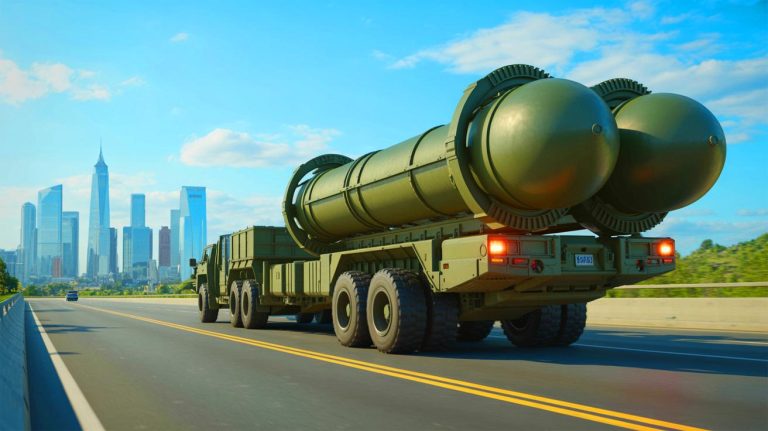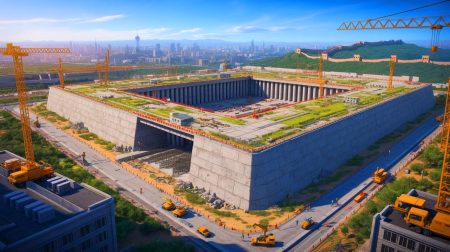| IN A NUTSHELL |
|
In recent weeks, the global defense community has been abuzz with discussions surrounding China’s latest possible military advancement: the HQ-29 missile defense system. Unconfirmed footage shared on Chinese social media platforms has triggered widespread analysis, suggesting that this advanced system could soon become a vital component of China’s missile defense strategy. The HQ-29, if officially acknowledged, promises to bolster China’s defensive capabilities, potentially rivaling the missile interception technologies of other major powers. With a potential public debut looming, the world is watching closely to see how this development might shift the balance of strategic power.
HQ-29: China’s Most Advanced Air Defense System
The emergence of the HQ-29 system has captivated military analysts and observers around the world. A recent video, posted on social media, showed a six-axle transporter erector launcher (TEL) carrying two large missile canisters. Each canister is approximately five feet in diameter, suggesting a substantial increase in China’s missile interception capabilities. The footage, although unofficial, has fueled intense speculation regarding China’s strategic intentions.
Military experts believe that this system represents a significant leap forward in China’s missile defense technology. The HQ-29 is thought to be a mid-course interceptor, designed to engage and neutralize threats in space during their coasting phase. This capability is crucial, as it allows for the interception of ballistic missiles outside the Earth’s atmosphere. The system’s dual role in anti-ballistic missile (ABM) and anti-satellite (ASAT) warfare further enhances its strategic value.
According to former PLA instructor Song Zhongping, the HQ-29 is comparable to the American Ground-Based Interceptor (GBI) and Russia’s Nudol anti-satellite system. If confirmed, this development would place China among the elite nations with operational exo-atmospheric interception capabilities, highlighting a significant advancement in its defense strategy.
Completing the Missile Defense Triad
The introduction of the HQ-29 could complete China’s three-tiered missile defense system. Currently, the HQ-9 series provides terminal-phase defense, while the HQ-19 offers high-altitude interception capabilities. The addition of the HQ-29 would fill the gap in mid-course interception, offering multiple opportunities to neutralize threats during a missile’s trajectory.
This strategic enhancement is crucial in modern warfare, where missile paths are more predictable during the mid-course phase, reducing civilian risk. Song Zhongping emphasized the importance of such systems, drawing parallels to the ongoing conflict between Israel and Iran, where mid-course defense has proven vital. Despite their high cost, systems like the Arrow-2 and Arrow-3 interceptors in Israel are considered essential for national security.
Should the HQ-29 be officially unveiled, it would not only signify technological progress but also demonstrate China’s ambition to achieve dominance in space. This development would mark a significant milestone in China’s quest for a comprehensive missile defense system in today’s increasingly multipolar world.
The Role of Unconfirmed Footage in Military Analysis
The circulation of unconfirmed footage on social media platforms has become a powerful tool in military analysis. In the case of the HQ-29, such footage has sparked widespread speculation and analysis, despite the lack of official confirmation from Chinese authorities. This highlights the growing influence of digital media in shaping perceptions and narratives around global defense developments.
While official statements remain the gold standard for confirming military advancements, unverified footage offers a glimpse into potential capabilities and strategic intentions. Analysts scrutinize these clips, comparing them with known technologies and systems to draw conclusions. This process underscores the importance of open-source intelligence in contemporary military analysis.
However, the reliance on unconfirmed footage also presents challenges. The accuracy and authenticity of such content can vary, leading to potential misinformation. As such, it is crucial for analysts and observers to approach these materials critically, corroborating them with additional sources and expert insights to form a well-rounded understanding of the situation.
Implications for Global Strategic Balance
The potential introduction of the HQ-29 has far-reaching implications for the global strategic balance. As China continues to enhance its missile defense capabilities, other nations may feel compelled to reassess their own defense strategies. This shift could lead to increased investments in military technologies and defense systems worldwide.
Moreover, the HQ-29’s dual role in ABM and ASAT warfare underscores the evolving nature of threats in modern warfare. The ability to engage both ballistic missiles and satellites highlights the interconnectedness of space and terrestrial defense strategies. As nations increasingly rely on space-based assets, the development of systems like the HQ-29 becomes even more significant.
In this context, the global community must consider the potential consequences of an arms race in space. The introduction of advanced systems like the HQ-29 could lead to increased tensions and competition among major powers. As nations navigate this new era of defense, the question remains: how will they balance the pursuit of security with the need for collaborative space governance?
As the world awaits an official announcement regarding the HQ-29, the implications of this potential advancement continue to unfold. The development of such sophisticated systems not only strengthens a nation’s defense capabilities but also reshapes the strategic landscape. In an era where technological prowess defines military strength, how will nations navigate the complexities of defense innovation and geopolitical rivalry?
Did you like it? 4.6/5 (22)








Wow, China really stepping up their game with the HQ-29! 🚀 What’s next, a space police force? 😂
How credible is this unconfirmed footage? Sounds like a lot of speculation without solid facts.
This article provides valuable insights into China’s strategic advancements. Thank you!
Interesting that military analysis now relies so much on social media footage!
Does this mean China can take out satellites? That could change everything!
So, are we looking at a future where space is the new battleground? 😬
If confirmed, how might this system affect China’s relations with the US and Russia?
HQ-29 might be China’s strongest card yet. But will it prompt others to catch up?
This feels like a Cold War tech race 2.0, but in space. History repeats itself!
Great article, but I wish there were more sources cited on the technical specs.
China’s latest move: strategic genius or reckless escalation?
What does this mean for smaller countries? Are they just caught in the crossfire?
HQ-29 vs. GBI and Nudol: who takes the crown for best missile defense?
Am I the only one who sees “Star Wars” coming true with this stuff? 🚀
Does this development make anyone else nervous about the future of space? 😓
What are the environmental impacts of such missile tests and defenses?
Are these systems foolproof, or do they come with significant risks?
Scary to think about the possibility of a space arms race. Are we really ready for that?
HQ-29 could be a game-changer, or it could just be another failed project. Time will tell!
Can we trust the sources of this footage? Misinformation is everywhere these days.
Intriguing article, but what’s the next step for international diplomacy here?
HQ-29 sounds like a big leap, but does it actually work as intended?
Does this mean the space race is back on, but with missiles instead of astronauts? 🌌
How should the international community respond to China’s advancements?
HQ-29 might change everything, but is it really worth the risk? 🤷♂️
Is there any possibility of international treaties to limit such developments in space defense?
HQ-29 sounds impressive, but does it work in practice? Testing is key, not just theory.
Thanks for the detailed analysis. Always good to stay informed about global military tech.
China’s HQ-29: game-changer or just another piece of military bluster? 🤔
How does this system compare to the US’s current capabilities?
Unconfirmed footage? Sounds fishy. How do we know this isn’t just propaganda?